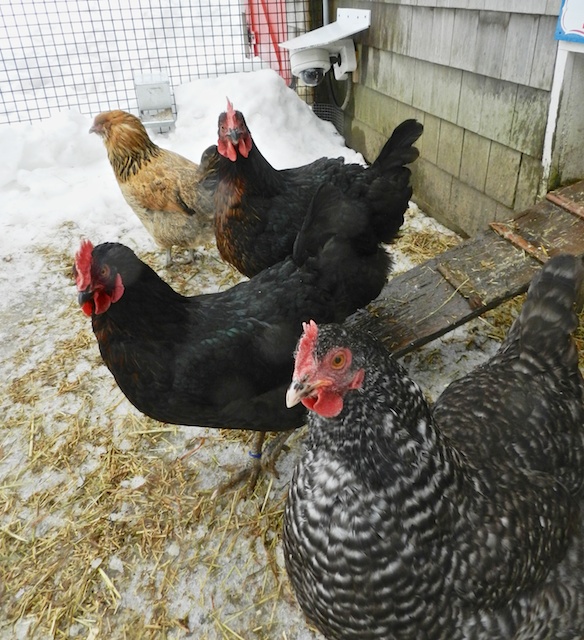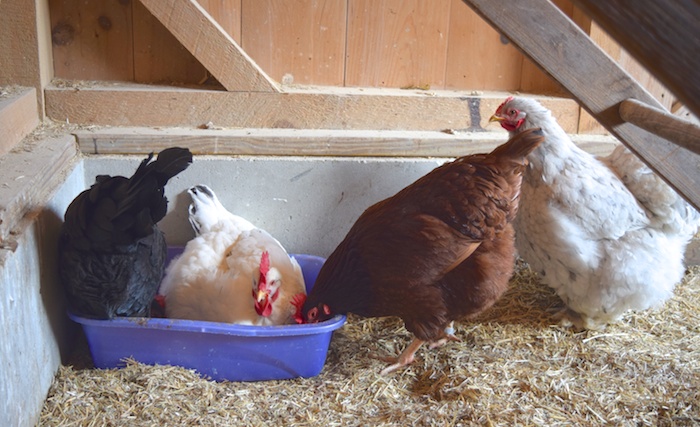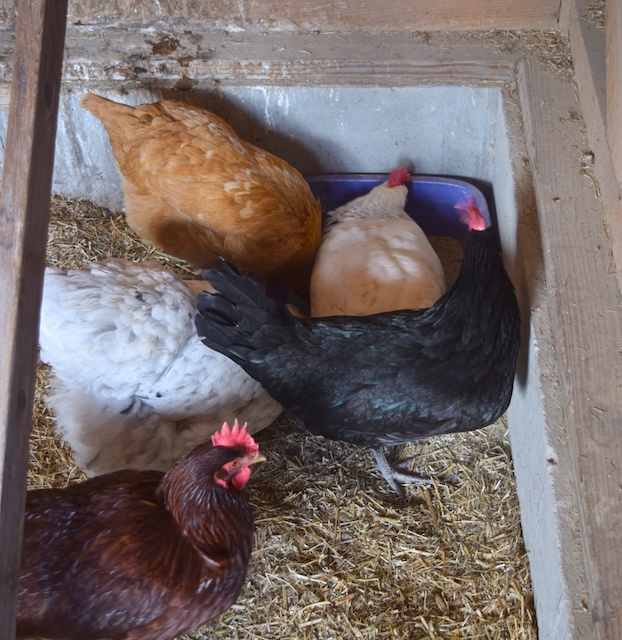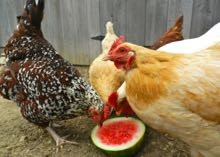Chickens need to take a bath at least once a day. Not a soap and water bath, but a dust bath. All chickens get external parasites, and the most common is lice. This is not the same pest that is feared by all parents of grade school children! Poultry lice are avian specific. They are soft-bodied insects that feed not on blood, but on the detritus of feathers and skin on a chicken’s body. (Photos on my FAQ.) All hens have a few of these moving about on them near the vent. Chickens keep the population of lice in check by taking daily dust baths in dry dirt, which acts to desiccate and kill them.
In the summer dust bathing is easy to do. Hens scratch up a dirt wallow and laze in it in the sunshine. It is a communal activity that they enjoy immensely (video here.) But, what to do when the ground, what can be seen of it, is frozen hard?
To keep your flock healthy and comfortable in the winter, you need to provide them with a dust bath. I use a kitty litter tub that I half-fill with inexpensive coarse builder’s sand (available at most hardware and lumber supply stores.) I stir in about a cup of food-grade diatomaceous earth. (Be very careful that this is not the agricultural DE advertised for dealing with slugs in the garden – that DE is microscopically so sharp that it can kill your chickens.) The sand, by itself, makes for a good dust bath, but the addition of food-grade DE makes it a tad more effective at drying out and killing the lice.
I place the dust bath in a sunny corner of the coop. This is yet another reason to have a spacious coop with windows that let the light in. Chickens won’t dust bathe in a dark, cramped coop. I clean it out weekly using a kitty litter scoop. In their enthusiastic bathing, the hens kick the sand out and so I replenish it every few weeks.
I know that there’s something appealing to the hens about fresh sand (like clean sheets on a bed for us?) because when I fill up the box, the hens jump in.
Opal, the Delaware, is always the first. She’s also quite large, but the other girls find a way to squeeze in. There’s quite the queue.
There’s much chortling and wing flapping. It reminds me of a bunch of tots enjoying a kiddie pool in the summer. There’s never enough room, but that’s part of the fun.




Great pics! Funny you should mention tots in a kiddie pool. I have 17 in my flock, so I had to find a little bit bigger dustbin – a child’s swimming pool, borrowed from my two dogs. At any given time, there are at least 12 of the hens in it. Family and friends find it quite amusing when they receive e-mail with photos of a pool full of fluffy chicken bottoms. A little sunshine on a dreary winter day. :) It’s only about 5 degrees F out there right now, but the pool is full!
You take such good care of your hens :)
I’ve heard of using food grade DE in their dust bath, along with a portion of wood ashes in order to help keep lice and mites in check. One idea we had, once I get through constructing the chicken yard, is to get one of those kiddie pools and fill it half way up with sand, along with the DE, and let them ‘have at it’!!
Be careful with wood ashes. In some cases, if they get wet, depending on the types of wood, they can get caustic. (Oak is a culprit.) That said, I give the girls ashes from the fireplace, mixed in their dirt holes.
Wish I was more sure about the type of sand to get at my local hardware store for their dust bath. I’ve went on one and they have play sand, all purpose sand, paver sand, and commercial grade sand, as in the type you would mix when mixing cement. You wouldn’t ‘happen’ to have a link for this, as you did with the DE, would you??
Avoid the fine playground sand. Any of the other varieties are fine. I buy all-purpose. The hens aren’t fussy.
OK, thank you!! I just want the best for my girls.
Be careful how much DE you put into their dust baths. I had read that a very small amount, a teaspoon, was enough. But I thought if a little is good, more is better so I used to put a big handful out in their outdoor dust bathing area.
I had three 6 month old hens present themselves with a respiratory condition that antibiotics would not kick. These three hens were raised together and were best buddies and did everything together including dust bath. They would kick up dust into each others faces.
UC Davis did my necropsy and said that their lungs were badly scared from inhaling the DE and silica from the sand. I was sick knowing that I had caused their deaths just as their lives were getting started.
Hi Amy, I’m assuming you had the food-grade? Because the other DE will kill like that, but food-grade isn’t as severe. But, in large quantities, it can (as you found out) cause problems. Also, what type of sand did you use? Fine playground sand has more silica than the coarser builders sand. There are always variables. My hens’ outside bath gets rained on. I’m sure that keeps the dust down and the finest particles get washed away. Inside, my coops have good ventilation with cupolas that draw air up and out. If you’re in an arid locale, the dust will be far worse. Enclosed pens will make dust worse. I’m sorry about your losses!
Have you had issues with keeping Pearl’s feathers clean due to being a cochin when it gets rainy, or muddy ? Have you had any lice issues, or has the DE food grade kept that down ?
Cochin butts can get messy, but Pearl does a good job of keeping clean. Because my hens dust bathe, lice issues are minimal. That would be true even if they just used sand and dirt. The DE just gives it an extra boost.
I have a turtle sand box for mine they love it… how early would you put a dust bath is with chicks
I’ve starting buying ‘natural’ play sand. The ‘natural’ play sand is supposed to have less silica dust. I have Hermit Crabs and fish that I use sand with. The texture is finer than the sand I used to buy. It reminds me of the sand I’ll find in my yard dirt and even looks like it. (i.e. it’s not ‘pretty’) I like it and, it might just be me :) , I think it carries less odor.
Great pictures, Terry! The new camera is awesome!
Thanks, I’m enjoying it, and still trying to figure out all of the buttons!
Terry, you always take great pics but the new camera makes it more fun =) My girls dust bath daily as you mentioned. Is there a health benefit of food grade DE when consumed by the hens when they pick through the sand?
Good question. Some people believe that the food-grade DE also kills internal parasites but there are no studies to confirm that.
Terry have you heard of a hen that wanted to try to dustbathe in mud ? She will dustbathe in dirt and has excess to sand inside, but her owner raised her with a lot of ducks and she seems to think she is one, because he has observed her getting down and rolling in the mud like the ducks. It’s not that she getting pounced on by the ducks or assaulted by them either.
My hens avoid mud.
Great photos! Velvet Sparrow, she has a live broadcast sometimes on Saturday or Sunday. One weekend it seemed like all her chickens were trying to fit in the tub at once! She has a LARGE tub and she has some LARGE Brahma and Cochin gals and a GIANT Cochin rooster in her mix of chickens! Dust bathing chickens are a blast to watch! Terry, your video is a favorite, especially with Miss Candy at the end! Reminds me of seeing photos of teenagers trying to all fit in a phone booth or VW Beetle!
The same behavior happens in nesting boxes. What one wants, they all want.